
Writing attractive job ads that attract your target candidate: How to Guide
A run-of-the-mill job posting won't cut it in today's candidate-driven market. As an employer or hiring manager, you've likely invested significant time and effort into creating job adverts, only to see top talent snapped up by competitors. It's a frustrating experience, primarily when recruiting for roles requiring niche skill sets.
Your job ad is more than just a list of requirements; it's your recruitment storefront, first impression, and a chance to captivate top talent. But how do you create a compelling job ad that attracts suitable prospective candidates?
This comprehensive guide will equip you with the tools and strategies to transform your job postings from overlooked to irresistible. We will explore everything from crafting attention-grabbing titles to leveraging SEO techniques to enhance visibility.
By the end of this guide, you'll be able to create an effective job ad that attracts your target candidates - those who align with your company values and possess the skills you need. Ready to revolutionise your talent strategy? Let's dive in and discover how to write a great job ad that stands out in the crowded talent acquisition marketplace.
Why Optimising Your Job Ads Matters
With unemployment low in Australia and talent competition fierce, writing a compelling job description is critical. Many employers underestimate the significance of this step in the recruitment process, but a well-crafted job ad can make all the difference.
Attracting suitable candidates:
An effective and optimised job ad can help employers attract employees with the right experience and cultural fit by acting as a precise filter. It clearly communicates the role requirements, responsibilities, and company culture, allowing candidates to self-select based on their qualifications and values. This targeted approach naturally draws in relevant applicants while discouraging those who don't align, ultimately saving your time and resources by reducing the influx of unsuitable candidates.
Increasing visibility:
Additionally, by incorporating relevant keywords, clear job titles, and compelling descriptions, your optimised ad is more likely to appear in top search results for both search engines and job search pages, ultimately improving your visibility with quality candidates.
What is the difference between a Job Ad and a Job Description:
Although sometimes used interchangeably, a job ad or job posting (Advertising a new role) isn’t to be confused with a job description (the job details) of that role. They are two separate things, but they must work together to attract suitable candidates.
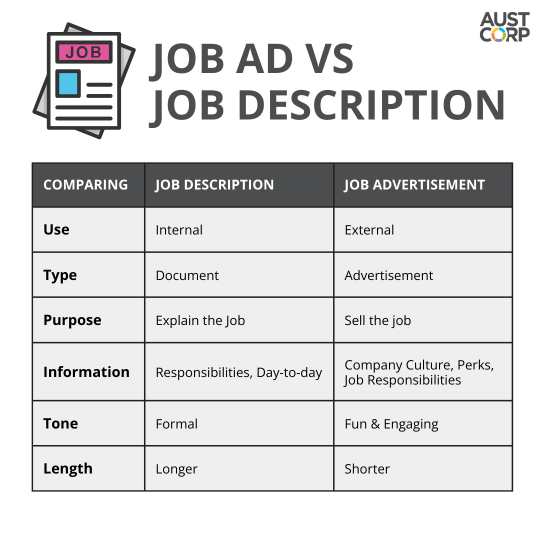
The Structure of an Effective Job Ad
When crafting an effective job advert, it is essential to understand the key components that make up a well-structured and effective job ad. Let's break down the essential elements that will help your job ad stand out and attract top talent.
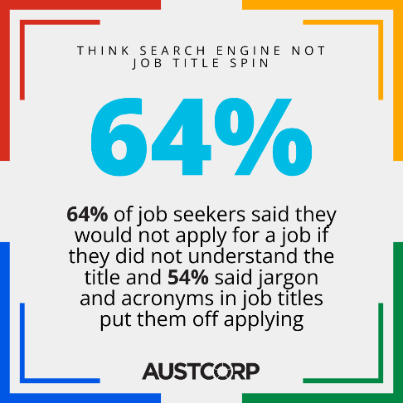
01. Clear Job Title
The headline is a crucial part of any advertisement. It's the first thing a candidate sees, and it's what will entice them to click and read more. So, make sure your headline is attention-grabbing and accurately represents the job.
Take your time with the job title; this is one area where creativity should be avoided. Avoid internal jargon, such as "Customer attention officer" rather than "Customer service advisor," and alternate wording like "guru” and “superstar”.
Job seekers typically use standard job titles when searching for new opportunities. Therefore it is recommended to use industry-known titles to ensure your post appears on search engines and job-search sites.
Pro tip: You can use the Australian Skill Clarification list to search industry-standard titles to ensure both search engines and applicants recognise your title.
02. Add a location (Even if it’s a remote position)
Including a location in your job advert is crucial for both SEO and user experience for several key reasons:
SEO & Job Search Boards: Job seekers will often use locations to filter out ads. When you don't include a location, your ad can often get lost when filters come into play. Including the location of the role in all key areas including the title, meta information and URL will increase the chances of your ad appearing in relevant search results.
User Experience: With factors like commute time, relocation needs and hybrid options being crucial information for many job seekers to consider a clear location is much needed to allow the candidates to quickly determine whether the role is the right fit for them.
03. Introduction – the hook
At the beginning of your job ad copy, briefly introduce the role and the business. Think of it as your elevator pitch, quickly hooking candidates so that they read on. State whom you are looking for, in which location, and briefly, what the role involves.
04. About Us Section
Your job ad's "About Us" section is your chance to shine and sell your company as a fantastic workplace. Here's how to make it count:
Highlight Your Company's Best Features
Mission, values, and vision: What drives your company?
Products or services: What sets you apart in the market?
Achievements and positive reputation: Any relevant awards or projects recently that will make your company stand out to a prospective employee (Ensure you cater this to the specific job).
Size and locations: Give candidates a sense of your company's scale.
Culture and inclusion: If you have official statements, include them.
Remember, don't just copy-paste from your website. Tailor this section to the role you're advertising.
Emphasise your Employee Value Proposition (EVP)
Your EVP is the secret sauce that makes your company irresistible to top talent. It's the total package of benefits and rewards – both tangible and intangible – that you offer in exchange for an employee's skills and dedication. Think:
Competitive salary and bonuses
Unique perks and benefits
Career development opportunities
Company culture and values
Want to learn how to develop your employer value proposition?: Check out our blog on Employer Branding: Turning your organisation into an employer of choice.
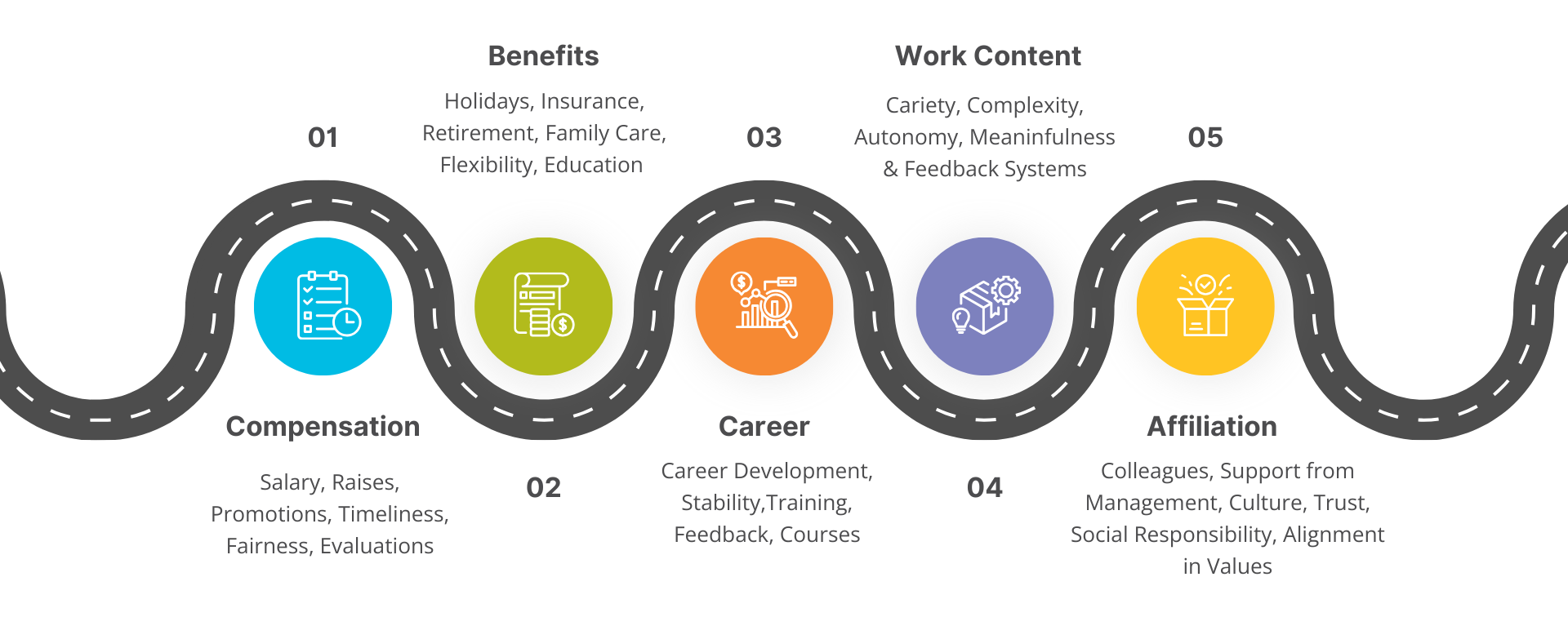
Show, Don't Tell
Anyone can claim to be "innovative" or have a "great culture." Set yourself apart by providing concrete examples:
Instead of "We're innovators," highlight specific products you've launched and their impact
Rather than "We have a sociable culture," describe team-building activities or social events you organise
Share employee testimonials or day-in-the-life stories
Include links to your company's social media, showcasing your culture in action
By focusing on specifics and backing up your claims with evidence, you'll create an "About Us" section that truly resonates with potential candidates and sets your company apart in the competitive job market.
05. Clear Role Responsibilities
When describing the role, your goal is to paint a vivid picture of the candidate's day-to-day life. Here's how to do it effectively:
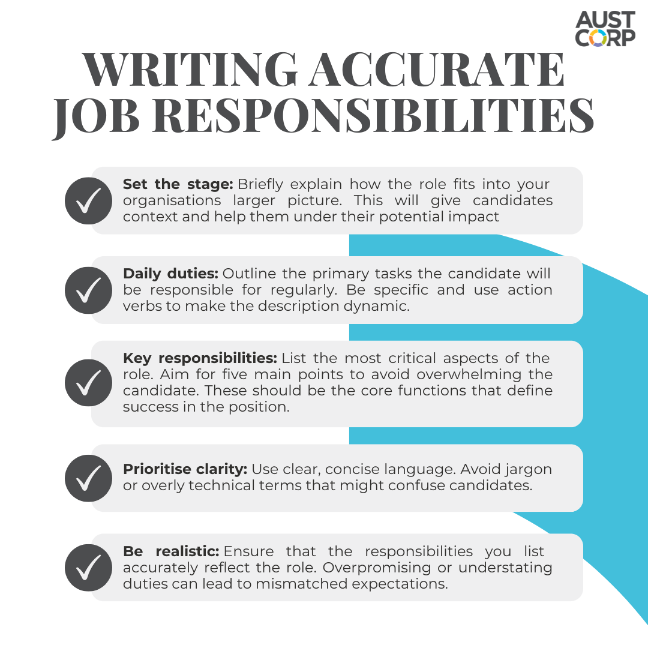
Remember, the goal is to give candidates a clear understanding of what the job entails without drowning them in details. A well-crafted list of responsibilities helps candidates self-select, ensuring you attract those genuinely interested and qualified for the role.
06. Specific Job Requirements
Crafting clear and accurate job requirements is crucial for attracting your target candidate and ensuring long-term employee satisfaction.
According to the SEEK Belonging Report 2022, 56% of individuals consider leaving a role within the first six months, often due to misalignment between the advertised position and actual job responsibilities. Ensuring your job ad accurately represents the role is crucial for retaining engaged and satisfied employees.
Here's how to create a compelling list of job requirements:
Essential Elements
Core skills: List the fundamental abilities needed for success in the role.
Key experience: Highlight relevant background that would benefit the position.
Necessary qualifications: Include any required degrees, certifications, or licenses
Best Practices
Use bullet points for easy readability
Keep language simple and jargon-free
Focus on competencies rather than years of experience
Consider transferable skills to widen your candidate pool
Distinguish between "must-have" and "nice-to-have" requirements
Avoid Common Pitfalls
Don't overwhelm candidates with an exhaustive list
Steer clear of vague descriptions
Be cautious about using "minimum years of experience" as a criteria.
07. Benefits
Some of the most common errors in job ads are when emphasising what the candidate must possess, whilst leaving out what they get in return.
Remember, candidates are tuned into "What's in it for me?" Your ad should answer this question. Research shows that ads focusing on what the employer offers are three times more likely to attract high-quality applicants who are a better fit for the role.
So, reflect on the benefits of the workplace. Involve your team and get their perspective on what makes the workplace positive.
Work-life balance: Be specific. Instead of vague statements, say something like, "We offer the ability to work from home twice a week."
Career development: Mention opportunities for growth, training programs, or educational assistance.
Company culture: Describe your workplace atmosphere and team dynamics.
Unique perks: Highlight any standout benefits that set you apart from competitors.
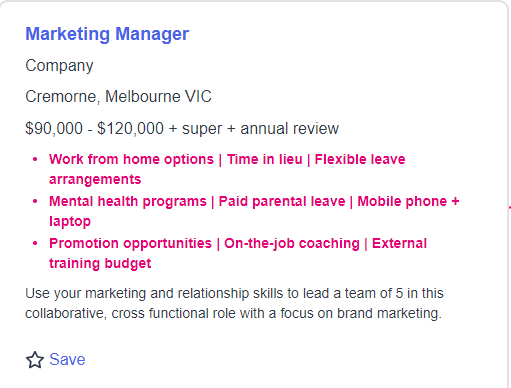
Your job ad is your first opportunity to influence a candidate's decision. If they can see their priorities reflected in your ad, they are much more likely to click on it. To ensure your benefits align with shared candidate preferences, use resources like Seek Law of Attraction Data to understand what drives the candidates in your market.
Include the top drivers of attraction in your job ad summary and key selling points to motivate candidates to apply.
READ MORE: Future of Total Rewards: Nine Trends to Watch for in 2025
08. Salary Information
Transparency about compensation is crucial in attracting top talent and streamlining your recruitment process. When you include salary information, candidates have the information they need to decide whether the role is the right fit for them, speeding up your process but filtering out candidates with unaligned expectations. It is important to ensure you are including a clearly defined salary range and a list of all additional benefits.

09. Call To Action
Closing your job ad with a strong Call-to-Action (CTA) and clear contact information is crucial for driving applications. A compelling CTA, such as "Apply Now" or "Join Our Team Today," creates a sense of urgency and encourages immediate action from interested candidates.
Including specific contact details or application instructions ensures that potential applicants know exactly how to proceed, reducing barriers to entry and increasing the likelihood of receiving quality applications. This final section of your job ad serves as the bridge between candidate interest and actual engagement, making it a vital component in your recruitment strategy.
Optimise for SEO
In today's digital age, many job seekers use search engines like Google, Bing, or Yahoo to find employment opportunities. To ensure your job postings appear in these search results and attract suitable candidates, optimising your ads for search engines is crucial.
Why SEO Matters for Job Ads
Increased visibility: SEO-optimized job ads rank higher in search results, making them more likely to be seen by potential candidates.
Targeted reach: Proper optimisation helps your ad reach the most relevant job seekers.
Cost-effective: SEO can be a more cost-effective recruitment strategy than paid advertising.
How to Optimise Your Job Ad for SEO
1. Incorporate Relevant Keywords
Research and use industry-specific keywords that job seekers are likely to search for. Tools like Google Keyword Planner, Answer the Public, and SEMrush can help identify popular search terms. Integrate these keywords naturally into:
Job title
Job description
Meta information
First 100 words of the job description
URL Slug
2. Optimise Page Titles
Include primary keyword near the beginning
Mention the job location
Keep it under 60 characters
Example: "Senior Software Engineer - Sydney | AustCorp"
3. Craft Compelling Meta Descriptions
Use primary keyword and location
Keep it under 160 characters
Include a clear call-to-action.
Example: "Join our innovative team as a Senior Software Engineer in Sydney. Apply now to build cutting-edge solutions at AustCorp!"
4. Create SEO-Friendly URLs
Include primary keyword and location
Keep it short and relevant
Example: www.austcorpexecutive.com/jobs/senior-software-engineer-sydney
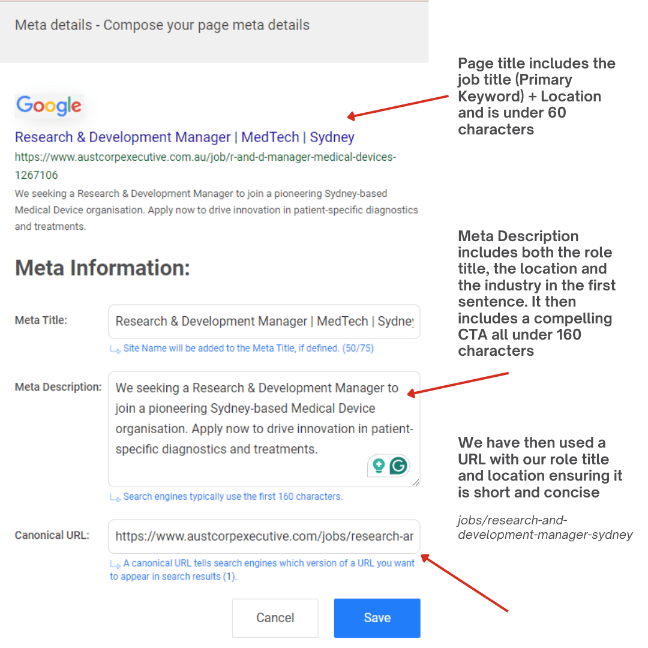
6. Develop a Dedicated Careers Page
Create a permanent careers page on your website to:
Showcase company culture
Highlight benefits and perks
List current job openings
View AustCorp's Career Page here to get some inspiration.
Other Key Tips To Ensure Your Post Is Optimised:
Writing inclusive job descriptions
A key aspect of crafting an effective job ad is using inclusive language. Certain words can exclude vast workforce sections, whether consciously or unconsciously. To help ensure you aren’t putting candidates off from a gender, race, or accessibility viewpoint, it is vital to comb through your wording.
Key Strategies for Inclusive Language
Remove gendered words and pronouns
Avoid gendered job titles (e.g., use "Salesperson" instead of "Salesman")
Eliminate derogatory or stereotypical terms
Use neutral language that doesn't exclude any group based on age, race, disability, or other protected characteristics.
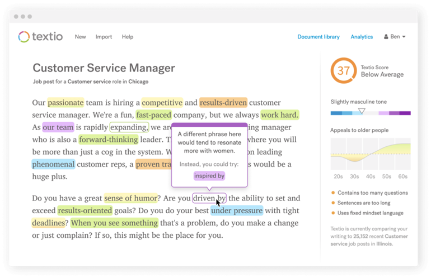
Tools to Help
Consider using language analysis tools like Textio, which can help identify potentially biased language and suggest more inclusive alternatives.
Include an EEO Statement
An effective Equal Employment Opportunity (EEO) statement demonstrates your commitment to diversity and can make your job ad more appealing to a broader range of candidates. It should clearly communicate that your company values diversity and does not discriminate based on protected characteristics.
See AustCorp's Equal Employment Opportunity & Diversity Policy here for an example.
Formatting your job ad:
A well-formatted job ad looks professional and enhances readability and user experience, increasing the likelihood of attracting quality candidates. Here's how to optimise your job ad's format:
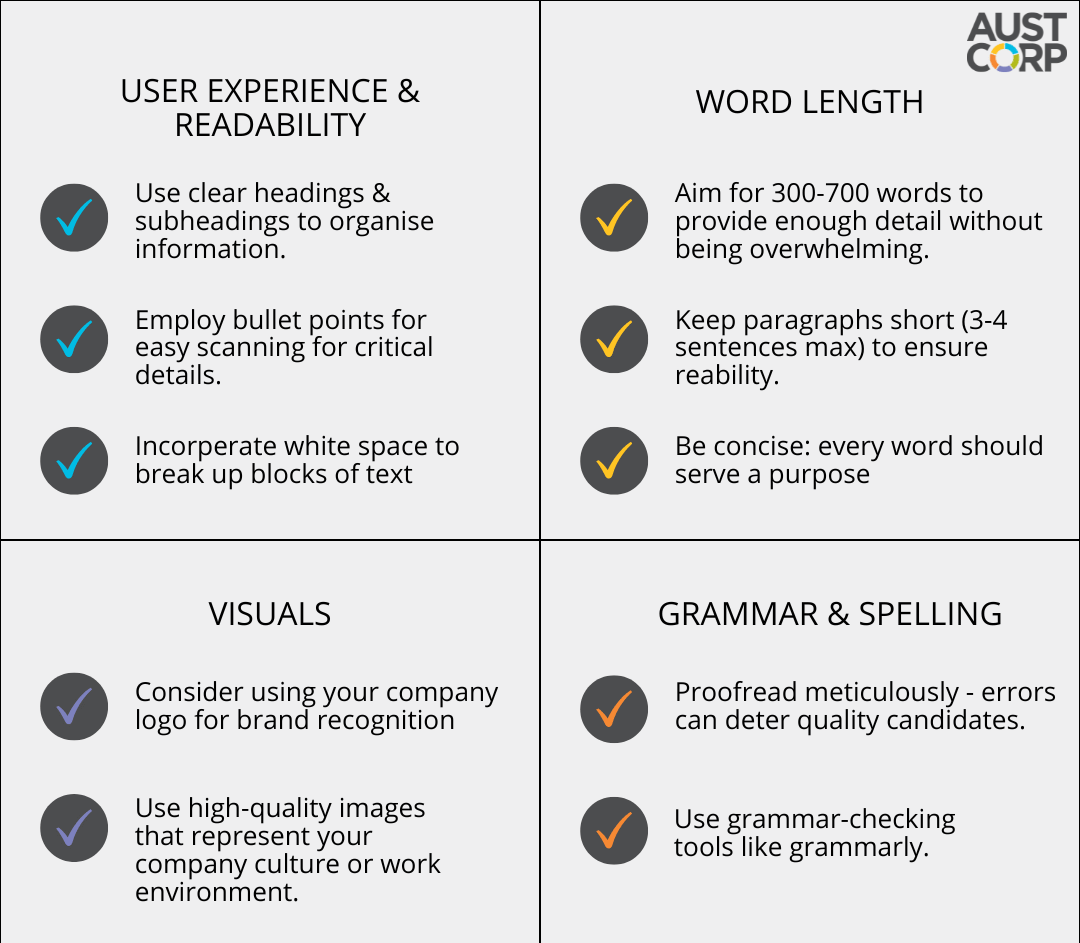
Explaining the hiring process
Transparency about your hiring process can significantly enhance the candidate experience and increase the quality of applicants. By outlining the hiring process, you are:
Setting clear expectations for the candidate
Demonstrating respect for a candidate's time and effort
Reducing anxiety and uncertainty for applicants
Showcasing your company's professionalism and organisation.
What to include:
Outline the main stages of your hiring process (e.g., application review, initial screening, interviews, assessments)
Provide an estimated timeline for each stage
Mention any unique elements of your process (e.g., group interviews, skill tests)
Explain how and when candidates can expect to hear back from you
Using data to make informed decisions
Continuous improvement is critical to effective job advertisement. Analysing your job ad metrics can help you identify what works and what doesn’t, allowing you to optimise your strategy over time.
Tracking key metrics: List down essential metrics you need to monitor to evaluate the effectiveness of your job ads. These may include the number of impressions, click-through rate, or application completion rates. You should also track the time it takes to fill positions and the progression of candidates for respective posts.
Use A/B testing: A/B testing of a job advertisement involves creating two adverts for the same job with minor differences to compare which advert attracts and converts a larger or more quality audience. Testing various headlines, descriptions of the job, or CTA can help you see what language and words work more effectively for a particular audience.
Leveraging Social Media for Job Advertisements:
In today's digital age, social media platforms have become powerful tools for job advertisements. They offer a unique opportunity to reach a broader audience and engage with potential candidates more interactively and dynamically. Here's how to effectively leverage social media for your job ads:
Choose the Right Platforms
Different social media platforms cater to various audiences. Select the ones that align best with your target candidates:
LinkedIn:
LinkedIn, a professional networking platform, is your go-to place to connect with both passive and active candidates. It offers a variety of ways to post a job, providing you with flexibility and control over your recruitment process.
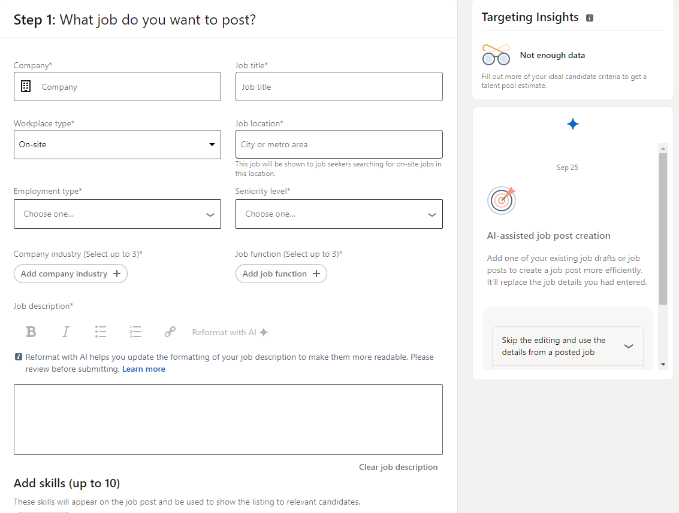
Free Job Ads: These ads are free to post and appear on the job page of your company profiles and the LinkedIn job search page for candidates.
Sponsored Job Ads: LinkedIn offers sponsored job slots, a powerful tool that allows you to target specific industries, roles, locations, and skills. By enabling applicants to apply using their LinkedIn profile, you can significantly speed up the application process, improving your application rates and giving you a competitive edge in the recruitment process.
General Post: You can also post a general post on your company page using either text format, a company-branded template or a video job ad to promote the role. Ensure you add the link to the job ad in the post's comments, as LinkedIn penalises posts that direct users to 3rd party sites.
It is also a good idea to ask your colleagues and hiring managers to repost the job or post to help reach a broader audience. It is also good to consistently share behind-the-scenes and employee-generated content with your feed to build your employer brand. By having a consistent feed of company-related posts and employee-generated content using various formats, you can make an effective employer brand that will ensure your job ad promises are backed up by the proof needed.
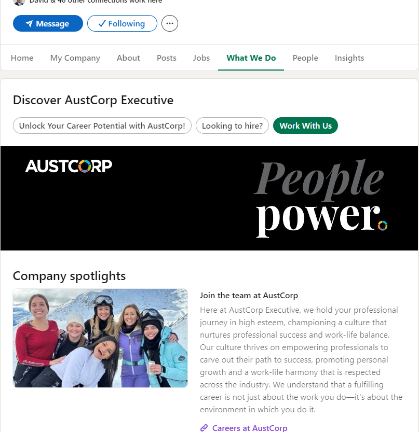
LinkedIn Company Profiles: A complete and optimised LinkedIn company profile serves as a powerful recruitment tool. By showcasing your company culture, values, and achievements, you can provide applicants with a comprehensive view of what it's like to work for your company.
Start with the "About Us" section, describing the companies purpose, mission and values as well as sharing key details about the company size, location & specalities.
Next, fill out the "What We Do" section, showcasing your companies culture and employer brand. This section is a great place to include employee testimonials, company photos and videos and employee-generated content.
Click here to view AustCorp's Company Profile to use as an example.
Facebook:
Facebook Ads for recruitment allow you to tap into the most prominent candidate pool in history, with 2.89 billion daily users globally. It is also important to note that Facebook Ads is integrated with Instagram, providing an additional visual dimension to your strategy through creative and visually appealing advertisements.
Facebook Job Posts: These straightforward, free listings are created directly under your company's job page, making them visible to followers and encouraging direct applications through the platform.
Facebook Employment Ads: These are paid advertisements targeted to specific demographics, interests, and locations beyond your existing followers, thus expanding your reach to a more diverse applicant pool.
Direct Post to your company feed: You may also like to post a direct post to your feed again, using text, image, video format and company branding to promote the job. Like LinkedIn, it is recommended that you ask your colleagues to repost the post to help reach a broader audience.
Tik Tok:
In today's digital world, TikTok is no longer just a fun and entertaining platform but an important AI-powered recruitment tool for businesses. For many companies, especially those wanting to hire new employees, the platform has 500+ million active users, mostly made up of young people.
One of the significant advantages of using the platform is the unmatched scope of coverage and participation. Regular job ads often get lost in the noise, but through its algorithm, TikTok powers this content to virality, reaching thousands, if not millions, of prospective applicants.
But organic reach alone is not enough. Brand humanisation is key on TikTok. Recruitment can often feel transactional, yet on TikTok, you can show the behind-the-scenes views, employee testimonials, team fun moments, ect. That way, candidates get a real taste of working at your organisation; they are not just applying for jobs but buying into a culture and community.
Examples of creative video job adverts on TikTok
Hello Social - 85.2K Views
Life at Brick House - 129.8K Views
Dacha Careers - 616.5K Views
Company Culture Video examples on TikTok
Spartanbtyinc - 40.4K Views
Truffle Social- 10K Views
Meaningfulsocialclub - 29.4K views
READ MORE: The ROI Of Employer Branding: How to Create a Compelling Workforce Brand
Streamline your Hiring Process with AustCorp Executive
If you are experiencing writer's block with your job postings, or simply don't have the time to spend writing and evaluating applicants, AustCorp Executive is here to help.
With over 27 years of recruitment experience, our tailored professional staffing services covering the ANZ, Oceania, and APAC region are designed to give you that edge, bringing specalised candidates into your fold. Backed by our 93% retention rate for exclusive contingent searches and a consistent 100% success rate for retained searches over the past years, AustCorp Executive can deliver a skilled and adaptive workforce that aligns with your long-term project goals.
Enquire Now for a confidential conversation with one of our Senior Consultants.
Read More Career Tips and Guides
Hungry for more career advice? Check out these relevant blogs to further enhance your professional journey:
